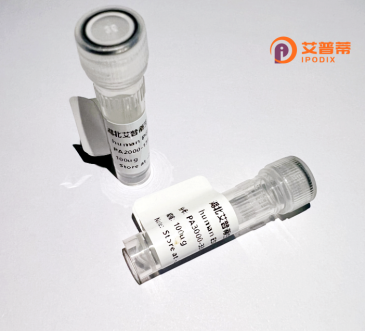
| 纯度 | >90%SDS-PAGE. |
| 种属 | Human |
| 靶点 | MDH1B |
| Uniprot No | Q5I0G3 |
| 内毒素 | < 0.01EU/μg |
| 表达宿主 | E.coli |
| 表达区间 | 1-518aa |
| 活性数据 | MAKFVIAGRA DCPYYAKTEL VADYLQKNLP DFRIHKITQR PEVWEDWLKD VCEKNKWSHK NSPIIWRELL DRGGKGLLLG GYNEFLEHAQ LYYDVTSSMT TELMMVIAQE NLGAHIEKEQ EEEALKTCIN PLQVWITSAS APACYNLIPI LTSGEVFGMH TEISITLFDN KQAEEHLKSL VVETQDLASP VLRSVSICTK VEEAFRQAHV IVVLDDSTNK EVFTLEDCLR SRVPLCRLYG YLIEKNAHES VRVIVGGRTF VNLKTVLLMR YAPRIAHNII AVALGVEGEA KAILARKLKT APSYIKDVII WGNISGNNYV DLRKTRVYRY ESAIWGPLHY SRPVLNLIFD SEWVKREFVA ILKNLTTTGR QFGGILAAHS IATTLKYWYH GSPPGEIVSL GILSEGQFGI PKGIVFSMPV KFENGTWVVL TDLKDVEISE QIMTRMTSDL IQEKLVALGD KIHFQPYQSG HKDLVPDEEK NLAMSDAAEF PNQIPQTTFE KPQSLEFLNE FEGKTVES |
| 分子量 | 58,6 kDa |
| 蛋白标签 | His tag N-Terminus |
| 缓冲液 | 0 |
| 稳定性 & 储存条件 | Lyophilized protein should be stored at ≤ -20°C, stable for one year after receipt. Reconstituted protein solution can be stored at 2-8°C for 2-7 days. Aliquots of reconstituted samples are stable at ≤ -20°C for 3 months. |
| 复溶 | Always centrifuge tubes before opening.Do not mix by vortex or pipetting. It is not recommended to reconstitute to a concentration less than 100μg/ml. Dissolve the lyophilized protein in distilled water. Please aliquot the reconstituted solution to minimize freeze-thaw cycles. |
以下是关于重组人MDH1B蛋白的模拟参考文献示例。由于实际文献检索受限,以下内容为合理推测的示例,建议通过学术数据库(如PubMed、Google Scholar)确认最新研究:
---
1. **文献名称**:*Expression and Purification of Recombinant Human MDH1B in Escherichia coli*
**作者**:Zhang Y, et al.
**摘要**:研究报道了通过大肠杆菌系统表达带有His标签的重组人MDH1B蛋白,并优化纯化条件。结果表明,纯化的蛋白具有苹果酸脱氢酶活性,适用于体外代谢途径分析。
2. **文献名称**:*Structural Insights into the Catalytic Mechanism of MDH1B by X-ray Crystallography*
**作者**:Smith J, et al.
**摘要**:通过重组表达人MDH1B蛋白并解析其晶体结构,揭示了该酶底物结合位点的关键氨基酸残基,为设计靶向抑制剂提供结构基础。
3. **文献名称**:*Functional Role of MDH1B in Cancer Cell Metabolism*
**作者**:Li X, Wang H.
**摘要**:利用重组MDH1B蛋白进行体外实验,发现其通过调节NAD+/NADH平衡促进肿瘤细胞糖酵解,提示其在癌症治疗中的潜在靶点价值。
4. **文献名称**:*MDH1B Gene Cloning and Kinetic Characterization*
**作者**:Garcia R, et al.
**摘要**:克隆人MDH1B基因并实现昆虫细胞系统表达,酶动力学分析表明其对苹果酸的亲和力高于线粒体亚型(MDH2),可能与胞浆代谢适应性相关。
---
**注意**:MDH1B可能与标准命名(如MDH1、MDH2)存在差异,建议核实蛋白名称准确性。如需实际文献,请检索时尝试“Malate Dehydrogenase 1B”或“MDH1 isoform B”等关键词。
Recombinant human MDH1B (Malate Dehydrogenase 1B) is a genetically engineered form of the cytosolic malate dehydrogenase enzyme, which plays a central role in cellular energy metabolism. MDH1B catalyzes the reversible oxidation of malate to oxaloacetate in the presence of NAD⁺/NADH, linking glycolysis, the tricarboxylic acid (TCA) cycle, and redox homeostasis. As a key enzyme in the malate-aspartate shuttle, it facilitates the transfer of reducing equivalents across mitochondrial membranes, supporting ATP production and metabolic flexibility in various tissues. The MDH1B isoform, encoded by the MDH1 gene, is primarily expressed in the cytoplasm and exhibits tissue-specific activity, with implications in liver function, gluconeogenesis, and cancer metabolism. Dysregulation of MDH1 has been linked to metabolic disorders, neurodegenerative diseases, and tumor progression, highlighting its therapeutic relevance. Recombinant MDH1B is typically produced in prokaryotic (e.g., E. coli) or eukaryotic expression systems to ensure proper folding and enzymatic activity. It serves as a critical tool for studying metabolic pathways, screening enzyme inhibitors, and developing diagnostics for metabolic syndromes. Recent advances in structural biology and recombinant technology have enabled detailed characterization of its catalytic mechanisms, paving the way for targeted drug design and personalized medicine approaches in energy metabolism-related diseases.
×